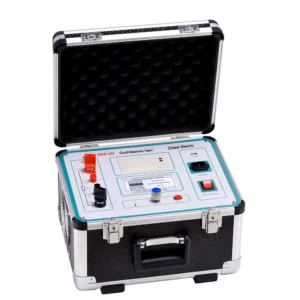Ground resistance testers, also known as earth resistance testers or ground impedance testers, are used to measure the resistance of the grounding system or earth electrode of electrical installations. These testers typically provide various reporting capabilities to document and analyze measurement results effectively.
Here are some common reporting capabilities of ground resistance testers:
- Measurement Results: Ground resistance testers display the measured resistance values directly on their built-in screens or digital displays. These measurements may include resistance values for each individual electrode or grounding point, as well as overall resistance values for the entire grounding system.
- Data Logging: Many modern ground resistance testers feature data logging capabilities, allowing users to record and store measurement data over time. These testers can store multiple measurement records, along with corresponding timestamps, measurement parameters, and location information, facilitating trend analysis and historical tracking of grounding system performance.
- Report Generation: Ground resistance testers may support the generation of comprehensive test reports summarizing measurement results and analysis. Users can customize report templates, add annotations or comments, and include relevant information such as test conditions, equipment used, and environmental factors. Some testers offer built-in report generation features, while others may require external software for report creation.
- Graphical Representation: Ground resistance testers may provide graphical representations of measurement data, such as line graphs or bar charts, to visualize variations in resistance values across different electrodes or measurement points. Graphical analysis can help identify trends, anomalies, or areas requiring further investigation within the grounding system.
- Data Transfer: Ground resistance testers often support data transfer capabilities, allowing users to export measurement data to external devices or software applications for further analysis and processing. Common data transfer methods include USB, Bluetooth, Wi-Fi, or SD card connectivity, enabling seamless integration with data management systems and reporting tools.
- Alarm and Alert Functions: Some ground resistance testers incorporate alarm and alert functions to notify users of measurement anomalies or out-of-specification conditions. These testers may trigger visual or audible alarms, display warning messages, or highlight abnormal measurement values, prompting users to take corrective actions or conduct follow-up inspections.
- Compliance Documentation: Ground resistance testers may assist users in documenting compliance with relevant industry standards, regulations, or safety requirements. Testers may include pre-programmed test protocols or measurement procedures based on applicable standards (e.g., IEEE, IEC), helping users ensure adherence to best practices and regulatory guidelines.
Overall, ground resistance testers offer a range of reporting capabilities to facilitate accurate measurement, analysis, and documentation of grounding system performance. These reporting features enhance data management, troubleshooting, and maintenance efforts, supporting the safe and reliable operation of electrical installations.

